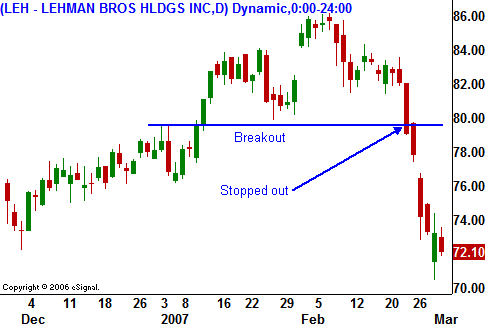Question
I pulled this question from the archives because the lesson still applies.
When we get stopped out on a put spread why do we close the whole position? I have noticed that if we covered the short leg and keep the long leg the chances are good that we will minimize our loss or possibly make a profit. A good example was the LEH put spread. Our stop was hit and we lost around $900. If we had held the long leg we would be up over $2K as of Friday. I realize that the down side is losing the spread minus the premium but if you are careful and watching what is going on with the markets the odds seem to be in your favor.
Answer
This is an excellent question. A few weeks ago, I suggested the LEH March 80-75 put spread after the company announced a massive buy-back. The spread would have been in good shape if the breakout held – it did not. My original game plan was to sell premium below that support and to let time take care of the rest. If I was wrong, I would take my lumps and move on. At the time, the market and the financial stocks had been strong.
Before I enter a trade, I form a concrete opinion of the stock. I am a directional trader and if I like it on a technical and fundamental basis, I will get long. In this case I liked the stock, but I wanted to give myself some cushion in case the stock was flat or even moved a little lower. Hence I sold a front-month put spread. The problem with buying in the 80 puts is that I have gone from being bullish on the stock to bearish in an instance. This type of flip-flopping will damage your confidence as a trader and it is not healthy.
I bought the whole spread back for $2 and lost $1 on the trade on 2/26. I can handle that loss psychologically and I still have the same long term view of the stock. In fact, with the recent sell-off, I’m looking to get long once the market stabilizes.
.
.
.
.
Now, let’s say that I want to second guess my original research. The stock brakes support during the market sell-off and I buy back the 80 puts. With 3 weeks left until expiration and the options in-the-money, they will be expensive. If the market jumps higher and the stock along with it, what do I do? Now I’m force to second guess my reactionary move. Was my original research correct and is the stock a good buy or is this a head fake bounce?
The worst case scenario is the stock keeps heading lower and I make money on the spread I legged out of. Now I have just paved the way to second guess myself any time the original trade doesn’t work. I have been down this road many times and the problem is that it does work sometimes. After all, the short leg of the spread should be just outside of a support or resistance level. Once that level is penetrated, the stock should continue the move in that direction. The problem is that the stock will sometimes move through those levels; take out the stops and reverse. I try to put my stops beyond the obvious level just to make sure it was not a head fake I was taken out on.
In the case of LEH, I still like the stock, but my opinion of the whole market changed in a day. The stop took me out of LEH and I was already shorting stocks where I had a bearish opinion. I have staying power in those positions because I am bearish on the stock.
Now, let me tell you of an instance where I will use your strategy. Mind you, this is the exception. If the stock has made a big move and the long option is trading for less than $.50, I will buy in the short option and let the long option run. The reason I feel comfortable doing this is because I am not risking more than an additional $.50. Chances are that the option is nearing expiration. If the breakdown in the stock is big and fast, there is a chance for continuation. To get to a level where I can scratch the whole trade, the stock has to make a big move. In order to make a profit, it literally has to fall apart (rocket in the case of call spreads) in a short amount of time.










